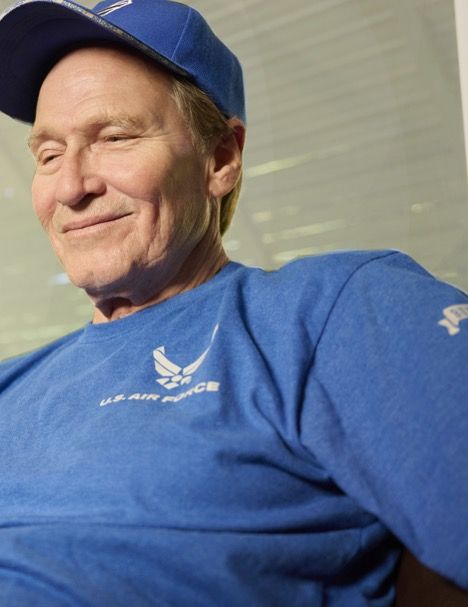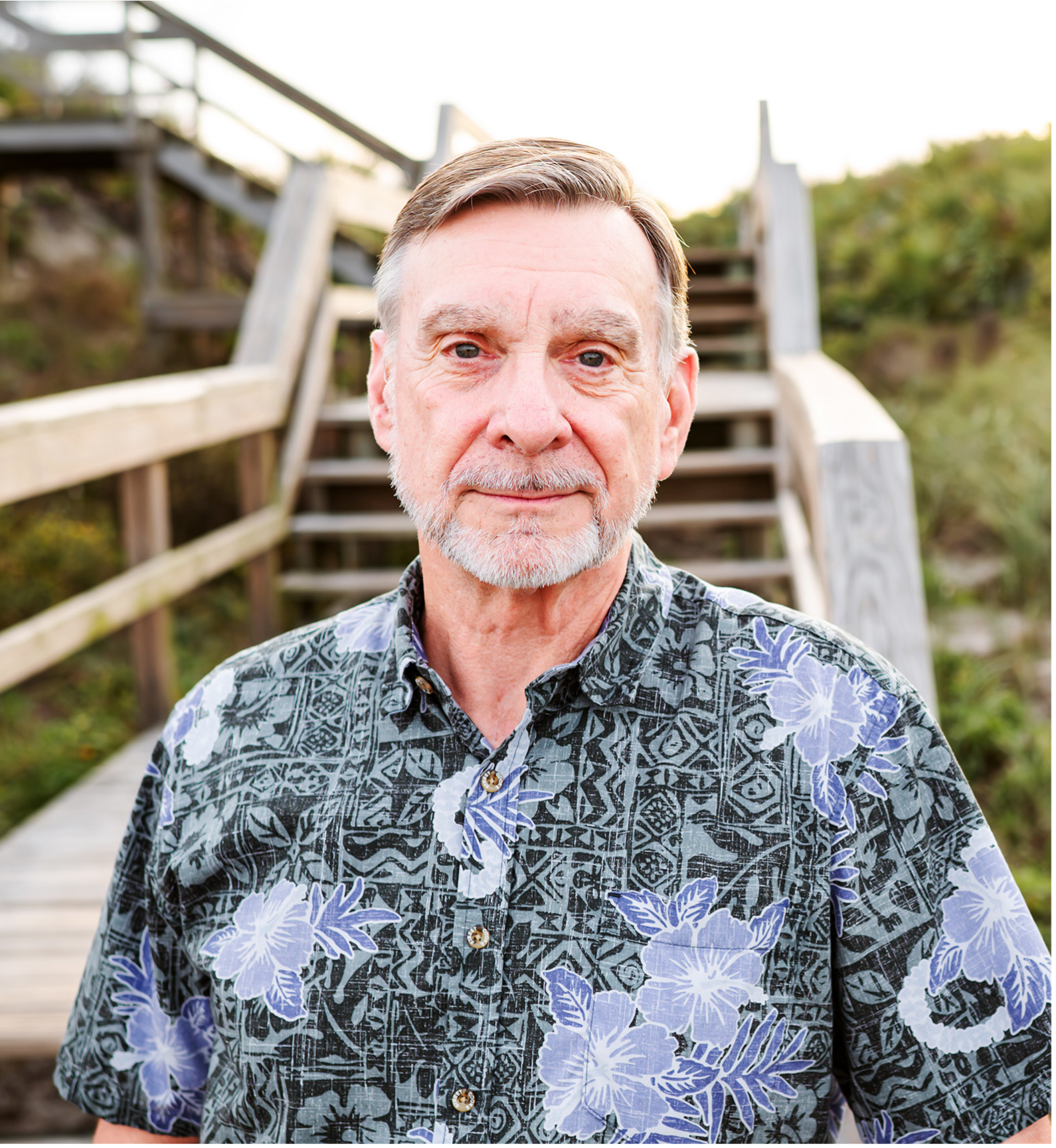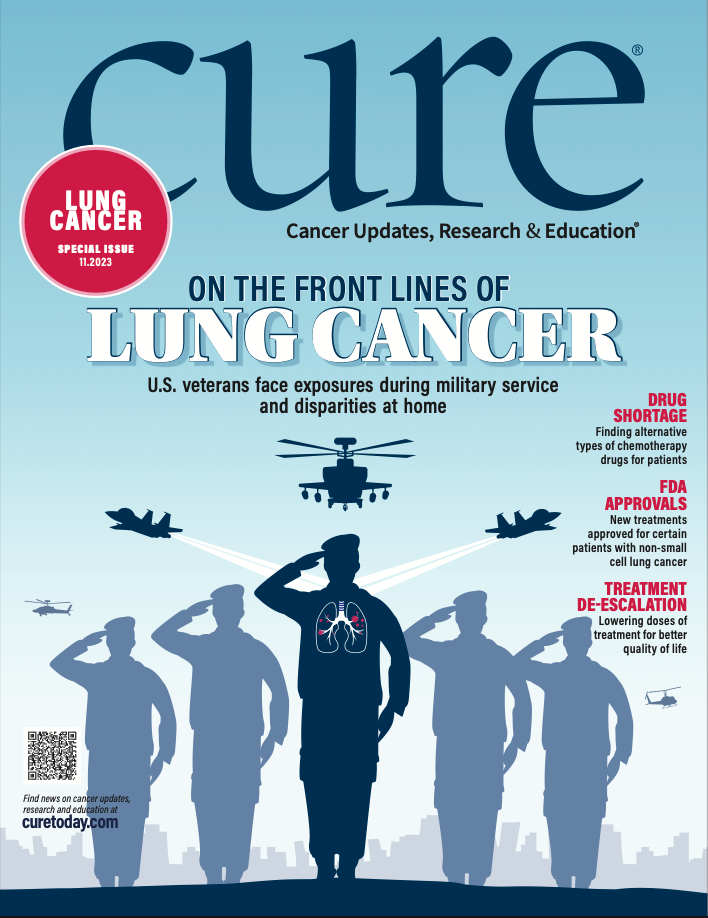News
Article
CURE
On the Front Lines of Lung Cancer
Author(s):
U.S. veterans face exposures during military service and disparities at home.
Brian Sturgill was originally told by doctors that they couldn’t do much for his lung cancer, until his doctor at the VA gave him hope.
Photo credit: LOCKINVAR DENIS

Brian Sturgill has spent 45 years serving his country. When the U.S. Air Force veteran and longtime registered nurse with the U.S. Department of Veterans Affairs (VA) in Miami received a diagnosis of metastatic lung cancer 11 years ago, he trusted his country to take care of him.
“Current workings at that time (were) basically (to say), ‘Oh, sorry, Mr. Sturgill, we’ll start you on hospice. It spread; there’s not much we can do,’ ” Sturgill, 65, tells CURE. “Luckily, Dr. Michael Campos at the VA said, ‘We’re going to fight through this, Brian.’”
Sturgill, who served as a medic and respiratory therapist in the Air Force, is among the nearly 8,000 veterans who, according to the VA Lung Precision Oncology Program (LPOP), receive diagnoses of lung cancer each year. The VA also states that approximately 5,000 veterans die of lung cancer annually and “an estimated 900,000 (veterans) are at risk for lung cancer due to age, smoking and environmental exposures during and after military service.”
Veterans, the VA states, have higher rates of lung cancer and lower rates of survival than the general population.
The Veterans Affairs Lung Cancer Surgery or Stereotactic Radiotherapy (VALOR) trial, which is sponsored by the VA Cooperative Studies Program, launched in 2017 and is expected to run through 2027. The trial is aiming to determine whether traditional lung-resection surgery or stereotactic body radiation therapy is preferrable for treating stage 1 non-small cell lung cancer (NSCLC).
UCLA Health calls it “the largest lung cancer treatment study ever,” with a patient population of 670 veterans.
Chief of thoracic oncology in the radiation oncology department at UCLA Health in California and co-chair of the VALOR trial, Dr. Drew Moghanaki, explains that while veterans with cancer face many of the same inequities that members of the general population do — stemming from intertwined factors including geography, socioeconomic strata and structural racism — those imbalances level out under the VA system due to its long commitment to tackling disparities at an enterprise level.
“We don’t see the same racial inequities that are observed in the general public,” Moghanaki says. “And the question, really, is ‘Why?’ Well, I think it’s primarily because in the VA, we espouse a culture to leave no veteran behind.”
'All in the Name of Protecting Our Country'
Sturgill, whose cancer had spread to his small intestine, underwent a small bowel resection and the removal of the upper lobe of his right lung and he also underwent chemotherapy.
“I had surgery, I had horrible chemo, but afterward, I was OK,” says Sturgill. “I’ve been OK until a recent PET (positron emission tomography) scan where it looks like something is brewing, but I’m not overly concerned about it in that sense. ... All the lymph nodes lit up this time, indicating something’s going on.”
“We know that lung cancer disproportionately affects our veterans,” says Dr. Charles B. Simone II of Memorial Sloan Kettering Cancer Center in New York and the New York Proton Center. “We know that lung cancer in general is one of the most common cancers in the United States, but whether it’s based on smoking exposure, environmental exposures or age, people that are in (or are) retired from the armed forces have disproportionately high rates of lung cancer, such that approximately 1 in 5 of all cancer diagnoses in our veterans are in lung cancer.”
Simone is a co-author of updated consensus quality measures for standards of care for veterans with lung cancer published in Practical Radiation Oncology, the result of a partnership between the VA’s National Radiation Oncology Program and the American Society for Radiation Oncology as part of the VA Radiation Oncology Quality Surveillance program.
“Two-thirds or more (of veterans with lung cancer) should be receiving radiation therapy as part of their multi-modality therapy or as their only therapy in some curative-intent purposes for early-stage lung cancer, yet fewer than half of our veterans do receive radiation therapy,” Simone says.
Interviews with 24 veterans with lung cancer at the VA Palo Alto Health Care System in California revealed that “social and economic disadvantages can prevent routine delivery of evidence-based cancer care,” with researchers also noting that “fragmented care contributes to worsening patient mental and emotional well-being,” “lack of health system interventions to address limited health literacy inhibits patient engagement in shared decision-making regarding diagnosis, genomic and molecular testing, targeted and other treatments and end-of-life care” and “deep appreciation for care and VA trustworthiness facilitates adherence to cancer care recommendations,” according to the authors of a report published in JCO Oncology Practice.
The same team of researchers reported that “the main barrier to lung cancer care was transportation with inadequate financial coverage for gas and extensive commutes that contributed to significant anxiety and stress regarding (patients’) cancer care” in a study published in the Journal of Clinical Oncology. They also noted that participants had difficulty comprehending and interpreting their diagnosis and were universally unaware of precision medicine such as molecular tumor testing and genomic cancer sequencing.
A study of racial disparities in lung cancer screening among veterans from 2013 to 2021 at Durham VA Health Care System in North Carolina, findings of which were published in JAMA Network Open, showed that Black veterans were 34% less likely to complete a lung cancer screening program than White veterans, with researchers noting that the disparity “persisted even after accounting for numerous demographic and socioeconomic factors.”
Nearly 19,000 veterans with clinical stage 1 NSCLC treated under the VHA system found that Black patients, while slightly less likely to receive lymph node sampling, were less likely to experience major post-surgery complications, according to results published in Chest. Black patients also had better risk-adjusted overall survival (length of time from diagnosis when a patient is still alive) and equivalent 30-day readmission and mortality as well as disease-free survival (period after primary treatment when a patient survives without signs of that cancer) when compared with White patients, the results established.
Veterans with clinical stage 1 NSCLC undergoing surgery who received treatment through the VHA had lower 30-day mortality (1.9% versus 2.8%) and higher media overall survival (71.4 months versus 65.2 months) when compared with similar patients from the general population of nearly 7,000 pairs of patients, according to findings published in Annals of Surgery.
“Veterans are unique. They tend to be older, they have other medical problems that go along with lung cancer that impact potentially how you treat their lung cancer, (and) more veterans live in rural areas,” says Dr. Shadia I. Jalal, director of the multidisciplinary thoracic oncology clinic at the Richard L. Roudebush VA Medical Center in Indianapolis, Indiana. “What might work in an academic center is not something that you can simply transplant and do at the VA, so there has really been rightfully a shift to really personalized care significantly in multiple ways at the VA, and this spans multiple things such as standardizing care. You want to make sure that every veteran in the country who is seen at a VA facility gets the optimal lung cancer care. The VA is the largest integrated health care system in the country, and so you really want to make sure you provide physicians (with) the tools (they need) to make sure that they are delivering the best care.”
One year after the 2021 launch of the VA’s LPOP, President Joe Biden signed the bipartisan Sergeant First Class Heath Robinson Honoring our Promise to Address Comprehensive Toxics (PACT) Act into law, heralded by the White House as “the most significant expansion of benefits and services for toxic exposed veterans in more than 30 years.”
During the first year of the PACT Act, according to the White House, more than 4.1 million veterans received free toxic exposure screenings through the VA, with the government processing nearly half a million PACT Act claims and delivering more than $1.85 billion in PACT Act-related benefits to veterans and survivors, including $215 million in benefits to veterans with cancer.
Under the PACT Act, respiratory cancers are considered presumptive conditions — meaning veterans do not have to prove that the cancer started during or worsened because of their military service — for veterans who experienced toxic exposures including Agent Orange during the Vietnam War and burn pits during the Gulf War and post-9/11 eras.
Burn pits, as detailed by the Associated Press in its 2022 reporting on the passage of the PACT Act, were utilized in Iraq and Afghanistan for the disposal of material including chemicals, medical equipment, human waste, cans, tires and plastics. Prior to the PACT Act, 70% of disability claims involving exposure to the pits were denied by the Department of Veterans Affairs, the Associated Press stated.
“There are large databases that provide a long list of chemicals on military bases that are carcinogenic. Some of them can be absorbed through the skin, some of them can be inhaled through vapors. Our veterans were also exposed to many of these chemicals when deployed to combat zones and were exposed to even more toxic chemicals” Moghanaki tells CURE.
“So, the list is long, and I tell you, someone who grows up and works in an office building and never worked around chemicals has a much different (level of ) risk (for) lung cancer than veterans who were on military bases touching this stuff (and) breathing this stuff, all in the name of protecting our country.”
Carl Schuck, now 76, was enlisted in the Air Force from 1966 to 1970, and during his Vietnam-era service, he worked in ground radio maintenance, stationed in Germany and then in Alaska. Schuck received a diagnosis of prostate cancer in 2017, and “during all of the testing and imaging, they noticed something on the X-rays, something on my lung,” he says.
Carl Schuck received a diagnosis of cancer nearly 50 years after serving in the Air Force.
Photo credit: BROOKE STACEY PHOTOGRAPHY

He was sent to a pulmonologist for further tests. “I was diagnosed with lung cancer, which was followed very shortly by surgery,” he says. “They resected my upper right lobe in my lungs.” He subsequently received five radiation treatments to treat nodules that were discovered in his left lung in the spring of 2022 and is now monitored by CT scans every three months.
Between those two treatment periods, Schuck experienced an early case of COVD-19 in March 2020, which resulted in him being placed on a ventilator for 15 days.
Schuck, a retired electronics engineer, made headlines in 2021 when through Florida donation center OneBlood, he hit the milestone of having donated 100 gallons of blood, a practice he began as a teenager and that he is unsure if he will be able to continue due to his cancer and treatment experiences.
'Just One of Those Things'
Schuck, like Sturgill, says he did not experience any toxic exposures during his service, noting that “my duty assignments were pretty mediocre as far as environmental (exposures). Except for the cold in Alaska, it was pretty tame.”
“The only thing is, I didn’t start smoking until Germany,” he says, “and then, I smoked about a pack a day for 18 years until I quit. So, that would be my only (exposure) but that wasn’t the Air Force’s fault, that was my own doing. ... You’re a young guy far away from home (in a) foreign land, peer pressure, just one of those things.”
As of 2005, 32% of active-duty military personnel and 22% of veterans smoked, compared to slightly more than 20% of the general population, with prevalence in smoking more than 50% higher among personnel who had been deployed, according to the 2009 National Academies Press publication “Combatting Tobacco Use in Military and Veteran Populations.”
Among the 18.8 million military veterans in 2015, 29.2% reported current tobacco use, according to an analysis of the 2010 to 2015 National Survey on Drug Use and Health cited in the Centers for Disease Control and Prevention’s “Morbidity and Mortality Weekly Report” in 2018.
C-rations, military field ration kits developed in 1938, included “chocolate or other candies, gum, biscuits and cigarettes,” according to the Department of Defense, and the practice of supplying troops with cigarettes didn’t end until 1975. Tobacco products are sold on military bases and for lower prices than off-base, according to research published in Tobacco Control.
“We certainly have a lung cancer problem in this country, and in particular among our veterans who were exposed to carcinogenic chemicals,” says Moghanaki. “It also stems from very aggressive tobacco marketing campaigns, including contracts with our military branches to push cigarettes into the ration bags of our soldiers who were just kids when they joined.”
Schuck says his care was covered through his own insurance.
“I’ve been told a number of times that I should have (applied) for VA benefits but in both mine and my wife’s careers, we had very good health insurance,” he says.
Nine million, or approximately half, of U.S. veterans are enrolled in the VA health care program, which includes more than 1,300 health care facilities, according to the U.S. Department of Veterans Affairs. As of September 2022, the VA reported that it was caring for more than 450,000 veterans with cancer and makes approximately 43,000 new cancer diagnoses annually.
Since retiring in February after nearly 40 years of service, Sturgill has returned to the VA to work on a South Florida Research Foundation lung cancer screening program research study housed at the Bruce W. Carter Department of Veterans Affairs Medical Center in Miami. His trust in the care he continues to receive through the VA remains unflappable.
“As an employee there and as a veteran, I feel very safe there,” Sturgill says. “And as a veteran, I feel safe at all the VAs with the care (they provide).”
For more news on cancer updates, research and education, don’t forget to subscribe to CURE®’s newsletters here.





